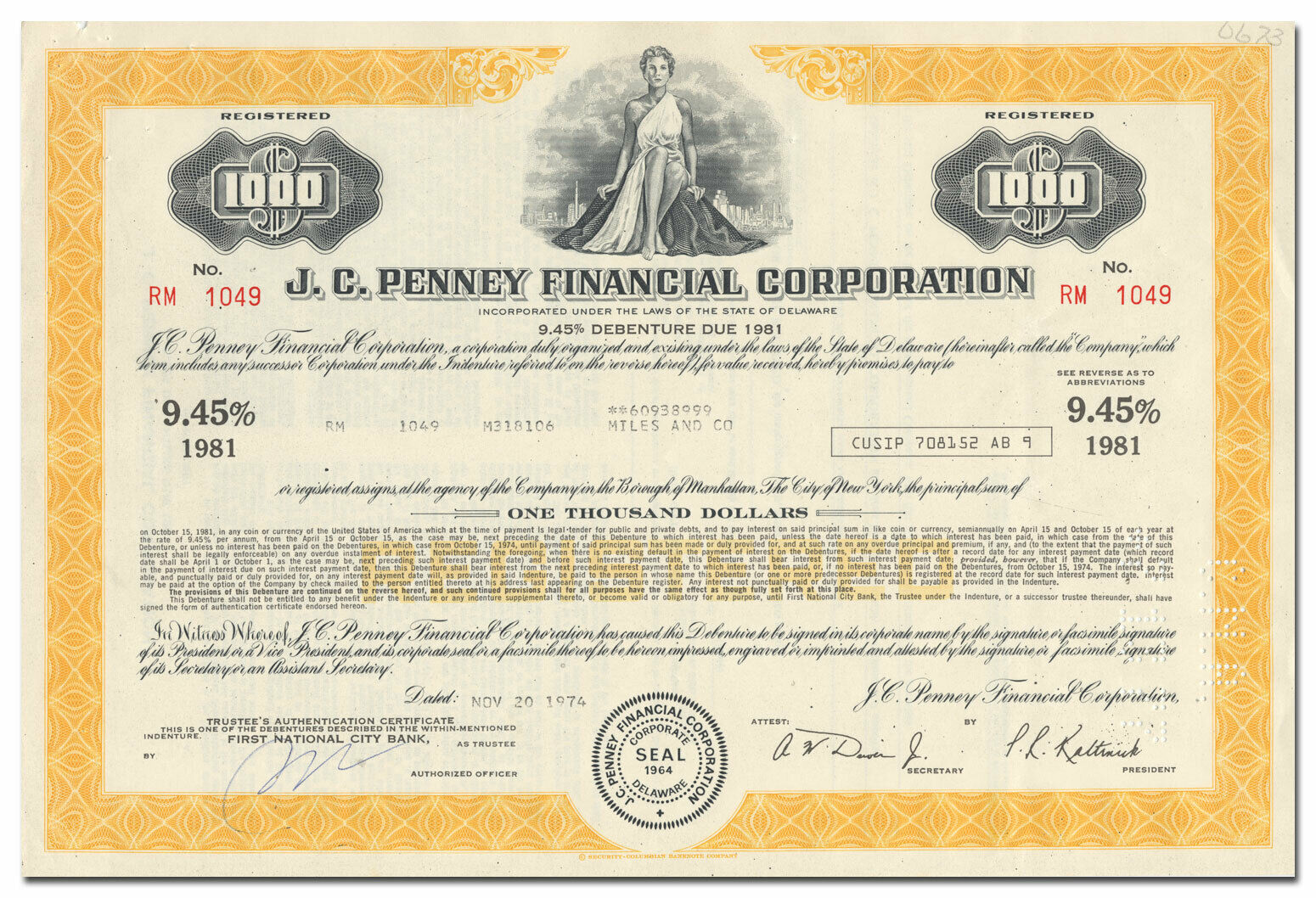-40%
J. C. Penney Financial Corporation Bond Certificate
$ 7.91
- Description
- Size Guide
Description
Product DetailsNicely engraved antique bond certificate from the J. C. Penney Financial Corporation dating back to the 1970's and 1980's. This document, which carries the printed signatures of the company President and Secretary, was printed by the Security-Columbian Bank Note Company, and measures approximately 12" (w) by
8
" (h).
The vignette features a female figure in front of a city skyline.
Images
The images presented are representative of the piece(s) you will receive. When representative images are presented for one of our offerings, you will receive a certificate in similar condition as the one pictured; however dating, denomination, certificate number and issuance details may vary.
Historical Context
Many courtesies that today's customers expect from a retail store such as money-back returns, standardized pricing, high quality merchandise, and friendly customer service simply were not widely practiced when Mr. James Cash Penney opened his first store in Kemmerer, Wyo., in 1902. In those days, many merchants operated their businesses under the motto "caveat emptor" - let the buyer beware! Customers had to be on their guard against shoddy merchandise, fraudulent claims about quality, deceptive dual pricing systems, highly discriminatory sales practices, and rude, uncaring sales people.
By 1913, Penney had grown his store into a chain of 36 locations, and incorporated the company in Utah as the JC Penney Company.
By the end of 1920, the chain totaled 312 stores in 26 states. The Company purchased the Crescent Corset Company, its first wholly owned subsidiary. It manufactured more than 500 styles of women’s lingerie exclusively for Penney stores. They were marketed under the name Lady Lyke, then Adonna.
In 1924, JC Penney opens its 500th store in Penney’s hometown of Hamilton, Missouri. The acquired store is the one in which Penney, age 19, got his first job in retailing in 1895.
On October 23, 1929 JCPenney common and preferred stocks are listed on the New York Stock Exchange for the first time. Six days later the stock market crashes on Black Tuesday.
In 1940, a young Sam Walton begins working in the Des Moines, Iowa, store. Eighteen months later he is called up for military service. After the war, he does not return to JCPenney, but launches out on his own, ultimately founding Wal-Mart. He, however, retains a high regard for JCPenney. He adopts many JCPenney strategies, like building stores in small-town America. In his autobiography he calls JCPenney "the cadillac of the industry."
In 1953, as the Cold War and the nuclear threat intensify, more than 50 mannequins wearing JCPenney clothes are exposed to an atomic blast at Yucca Flat, Nevada. They are then displayed at stores nationwide to show shoppers what type of clothing offers the best protection to a blast.
The famous JC Penney catalog is introduced in 1963, and by 1979 catalog sales exceed billion.
In 1996, the Company acquires several drugstore chains: Fay, Kerr, and several Rite Aid stores. This acquisition momentum climaxes with acquisition of the Eckerd Corporation in November. All are merged with Thrift Drug to create one of the nation's premier drug store businesses, with over 2,800 stores. Penney’s exits the drugstore business in 2004, selling all of its Eckard’s assets.










